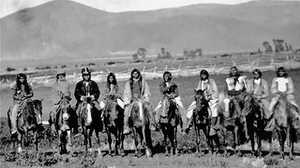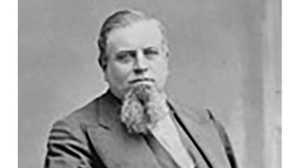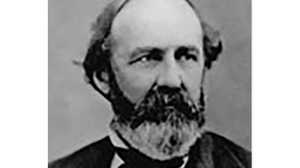Oakes Ames

"King of Spades" Oakes Ames, a Massachusetts businessman and politician, made his money as part of of Ames & Sons, a shovelworks founded by his father and administered by brother Oliver. The company found success providing shovels to miners during the gold rush. The transcontinental railroad would bring him even more wealth -- until 1873, when the Crédit Mobilier scandal destroyed his career.
"You Are the Man to Do It"
Ames had been an early investor in the Central Pacific, loaning Collis Huntington $200,000 of seed money in 1862. Two years later, during his first-term in Congress, Ames served on the House committee that passed an amended Pacific Railroad bill. The town of Ames, Iowa was named after him in 1864. In early 1865, as the Union Pacific floundered under the direction of Thomas Durant, Abraham Lincoln took Ames into his confidence. "Ames, you take hold of this," the president told him. "The road must be built, and you are the man to do it. Take hold of it yourself. By building the Union Pacific, you will be the remembered man of your generation." Thus anointed by his president, the U.S. Representative from Massachusetts bought into Crédit Mobilier and turned his energies toward representing it in the Capitol. He also secured for Durant most of the early Crédit Mobilier leaders, among them his brother Oliver Ames.
Power Struggles -- and Profits
An 1866 contract dispute put Oliver into the Union Pacific presidency over Durant, who had presumed himself the natural choice. Durant promptly filed an injunction halting line construction. Further lawsuits paralyzed the railroad. The Ames brothers marshaled support to depose Durant from the executive committee. For months a heated battle raged, rending the board in two. Oliver Ames was not leader enough to manage the division, so he acquiesced to readmitting Durant in late 1867. Crédit Mobilier awarded a new construction contract to Oakes Ames, who (like Durant before him) subcontracted work to crews led by Jack Casement. The line moved forward, and resulting profit patched the breach. Soon, Crédit Mobilier stock boomed.
Buying Support
Since joining Crédit Mobilier Ames had peddled its stock to his fellow legislators in hopes of influencing railroad legislation. In 1865 he had brought in fellow Massachusetts representative Samuel Hooper. A third congressman from the Bay State, John B. Alley, followed in 1866, as did Iowa senator James Wilson Grimes. Congressman Benjamin M. Boyer of Pennsylvania also accepted stock from Durant.
Feeding Frenzy
Crédit Mobilier reported returns of over 90% in 1867, and Ames suddenly found himself deluged by colleagues hungry for a piece of the sweet deal. "There were so many who talked to me about getting an interest in it," he would later confess. "I cannot recollect all the names."
Speaker of the House and future vice president Schuyler Colfax of Indiana signed on. So did Massachusetts senator and future vice president Henry Wilson, Ohio representative and future president James Garfield, James W. Patterson of New Hampshire, Henry Laurens Dawes of Massachusetts, John Bingham of Ohio, John A. Logan of Illinois, William B. Allison and James F. Wilson of Iowa, and two Pennsylvania representatives, William D. "Pig-Iron" Kelley and G.W. Scofield. Like Ames, they were Republicans all, and all voted on railroad matters. Lone Democrat James Brooks of New York, as a government director of the Union Pacific, was prohibited by law from owning company shares; he bought them in his son's name. Ames dispensed securities in blocks of 10 or 20, often keeping them under his name to simplify matters. The only members of Congress to get cold feet, Allison and both Wilsons, returned their holdings in 1868 or 1869, when Ames bought them back at face value plus interest. Others he approached, such as Maine's James G. Blaine, declined the offer. Ames kept track of all offers and transactions in a little black ledger.
Investigation
Abraham Lincoln had predicted the railroad would bring Ames a legacy; instead, it brought cruel infamy. Called before an Congressional investigative committee led by Vermonter Luke Poland in 1872, Ames admitted all exchanges had been "influenced by the same motive -- to aid the credit of the road." He insisted however that dispensation had been a matter between friends and therefore not illegal. Under this pretense, he agreed to name stock recipients. Horrified legislators aligned themselves against the King of Spades. Seeing that he was being made a scapegoat, Ames produced his ledger of names and amounts. "Ames had been bullied and badgered till his patience and good nature were exhausted," wrote a friend. "Sorrow and determination were written in every line of his strong face. He looked broken."
Ignominy
Ames' revelations had few repercussions. The Republican-led committee chose to punish Democrat James Brooks alone among the stockholders. Ames was another matter. The committee ruled that Ames had caused Congress "contempt and disgrace," and that his criminal acts of bribery had sullied the House and the legislative process. The Poland Committee did not, however, see fit to reprimand those who had been so willingly bribed. Nor would Durant or any of Ames's associates ever face punishment. Only a last-minute resolution of Congress saved Oakes Ames from expulsion. Censured, he returned home to Massachusetts; by May 1873 he was dead from a stroke, crushed by the weight of the ordeal.
Lonely Monument
Eight years after Oakes's death, the Union Pacific commissioned an unusual 60-foot memorial to the two Ames brothers whose unethical dealings helped build the railroad. The Ames Pyramid, built of granite at the highest point of the UP line, was designed by the great American architect H. H. Richardson, whose famous buildings include Boston's Trinity Church and the Marshall Field Wholesale Store in Chicago. Sculptured likenesses of the brothers were provided in bas-relief by Augustus Saint-Gaudens, the equally well-known artist whose likeness of William Tecumseh Sherman stands at the entrance to New York's Central Park today.
Over time, the Union Pacific line was moved, and today the Ames Pyramid stands alone in the landscape near Laramie, Wyoming, a curious monument to the men who built the railroad -- by hook or by crook.







